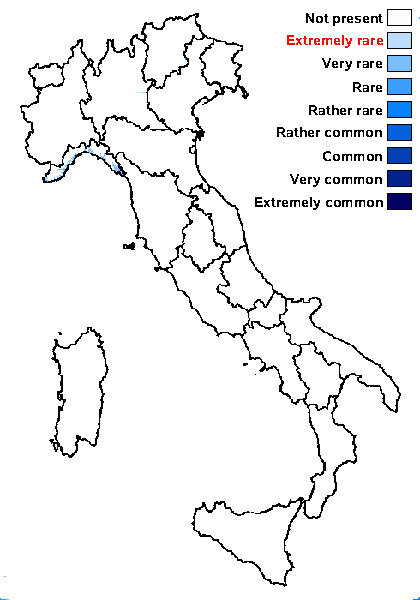Leptogium terrenum Nyl.
Bull. Soc. Linn. Normandie, 2, 6, 1872.
Synonyms: Amphidium terrenum (Nyl.) Nyl.; Epiphloea terrena (Nyl.) Trevis.; Leptogium crozalsianum Harm.
Distribution: N - Lig (Watson 2014).
Description: Thallus subcrustose to subsquamulose, pale brown to yellowish grey, sometimes thin and inconspicuous, when well-developed formed by 0.4-1.2 mm broad and 0.1-0.2 mm thick, digitate-lobulate areoles radiating all around the apothecia; lower surface paler, attached by stout, pale rhizohyphae composed of 1-2 rows of isodiametrical cells. Thallus paraplectenchymatous throughout, of mostly anticlinally arranged, reticulate hyphae composed of elongated cells; upper and lower cortex with (1–)2-3 layers of small isodiametrical cells. Apothecia frequent, without a distinct thalline margin, but often containing algal cells at the base of the proper margin, round, sessile, 0.5-1 mm across, with a reddish brown to brown-black, flat, smooth disc and a thin, smooth, persistent proper margin. Proper exciple distinct, colourless, composed of small cells, the basal parts often with clumps of photobionts; epithecium reddish brown; hymenium colourless, 100-125 µm high, K/I+ blue; paraphyses simple, straight, 1.5-2 μm thick at mid-level, the apical cells slightly swollen; hypothecium colourless to pale yellowish brown. Asci 8-spored, narrowly clavate, the apex strongly thickened, the apical dome K/I+ pale blue, with a downwardly projecting K/I+ deep blue tubular structure. Ascospores submuriform, with 4-7 transverse septa and a few longitudinal septa, hyaline, narrowly ellipsoid, (15-)18-26(-33) x (5-)9-12(-14) µm. Photobiont cyanobacterial (Nostoc, the cells in short chains or in more or less rounded clumps). Spot tests: all negative. Chemistry: without lichen substances. Note: on bare siliceous soil in Mediterranean grasslands and garrigues; probably much overlooked in Italy, but certainly not common, being known from a single station in Liguria. On its systematic position see Schultz & al. (2015).
Growth form: Crustose
Substrata: soil, terricolous mosses, and plant debris
Photobiont: cyanobacteria, filamentous (e.g. Nostoc, Scytonema)
Reproductive strategy: mainly sexual
Commonnes-rarity: (info)
Alpine belt: absent
Subalpine belt: absent
Oromediterranean belt: absent
Montane belt: absent
Submediterranean belt: absent
Padanian area: absent
Humid submediterranean belt: absent
Humid mediterranean belt: very rare
Dry mediterranean belt: absent

Predictive model
Herbarium samples
Growth form: Crustose
Substrata: soil, terricolous mosses, and plant debris
Photobiont: cyanobacteria, filamentous (e.g. Nostoc, Scytonema)
Reproductive strategy: mainly sexual
Commonnes-rarity: (info)
Alpine belt: absent
Subalpine belt: absent
Oromediterranean belt: absent
Montane belt: absent
Submediterranean belt: absent
Padanian area: absent
Humid submediterranean belt: absent
Humid mediterranean belt: very rare
Dry mediterranean belt: absent

Predictive model
| Herbarium samples |
 INDEX FUNGORUM
INDEX FUNGORUM
 GBIF
GBIF




